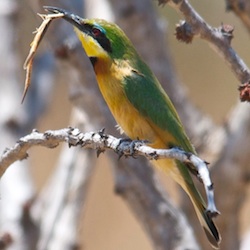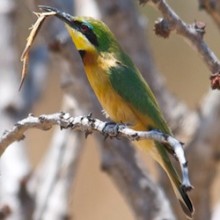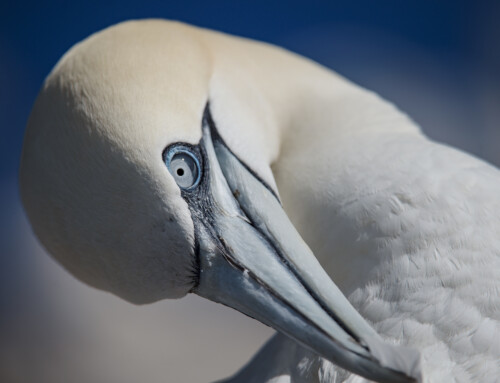Can Little Bee-eaters defend their nests from parasitism by Greater Honeyguides?
LINKED PAPER
The sight of an adult brood parasite near the nest is an insufficient cue for a honeyguide host to reject foreign eggs
Wenfei Tong, Nicholas P. C. Horrocks & Claire N. Spottiswoode. 2015. IBIS. DOI: 10.1111/ibi.12254.
Brood parasites like cuckoos are notoriously costly to host species, because raising parasitic young often comes at the expense of losing their own offspring. The best way for host parents to avoid these costs is to prevent parasitic eggs from being laid in the first place, by recognising and attacking cuckoos at the nest. Nicholas Horrocks, Claire Spottiswoode and I recently published a paper investigating this form of defence by Little Bee-eaters Merops pusillus, a common host of the brood-parasitic Greater Honeyguide Indicator indicator at our study site in Zambia.
The Greater Honeyguide is a particularly virulent African brood parasite. The adult females puncture host eggs when laying their own, and honeyguide chicks hatch with a special beak hook which they use to stab and kill all the other chicks in the nest, allowing the honeyguide chick to monopolise the host parents’ care.
Footage of Greater Honeyguide killing newly hatched foster sibling © Cambridge University
As a result of this deadly behaviour, we predicted that Little Bee-eaters would be extremely good at mobbing honeyguides lurking near their nests. We also expected that, if exposed to an experimental honeyguide intruder and an experimentally added foreign egg added to their simulating real parasitism, most bee-eaters would reject their eggs and start a new clutch. This is because Greater Honeyguide females typically puncture all the eggs in a nest before laying their own, so if the bee-eaters could tell they had been parasitized, they would do better to abandon their damaged eggs and start afresh.
To test these predictions, we placed stuffed greater honeyguides (and Black-collared Barbets Lybius torquatus as controls) outside the nesting burrows of Little Bee-eaters, and then sat back and watched how long it would take for the bee-eaters to come home, notice the intruder, and attack.
Little Bee-eater mobbing Greater Honeyguide
We expected the bee-eaters always to mob honeyguides, but not the harmless barbets. We also experimentally parasitized half the nests by adding a dove egg (similar in size to a honeyguide egg), and checked the nests the following day to see whether the bee-eaters had ejected all their eggs from their nest burrow, something that we’ve seen them do before when parasitized by a real honeyguide.
To our surprise, only about half the little bee-eaters we tested attacked a stuffed Greater Honeyguide at the nest entrance, and none of the bee-eaters rejected their clutch, even after attacking a honeyguide and being experimentally parasitized.
At this stage, our experiment could suggest that there is imperfect adaptation on the side of the hosts in this evolutionary arms race, with the Little Bee-eaters lagging behind in their inadequate defences against Greater Honeyguide parasitism. Alternatively, perhaps our experiment was imperfect, and bee-eaters need additional and still unknown cues of parasitism before rejecting their eggs. We plan to continue exploring this fascinating host-parasite system, which can still teach us more about coevolution and interactions between species.
All images © Wenfei Tong
If you want to write about your research in #theBOUblog, then please see here.








